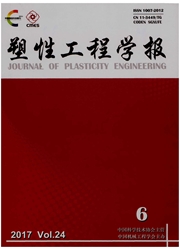

 中文摘要:
中文摘要:
激光拼焊板成形极限图(FLD)目前主要由试验法获得,但试验法由于其局限性,在实际应用中受到很大的限制。该文介绍了一种预测板料发生颈缩的新准则——厚度梯度准则,该准则基于当板料发生颈缩时沿垂直于颈缩方向的厚度梯度分布上存在着临界值C;在板料成形过程中,当其厚度梯度值小于临界厚度梯度值C时,板料发生颈缩。采用eat/Dynaform软件仿真了高强度钢B170P1激光拼焊板的凸模胀形试验,基于厚度梯度准则有限元计算获得了其成形极限图。获得的激光拼焊板FLD与通过凸模胀形试验法得到的结果进行了对比分析。与试验得到的数据吻合较好,从而证实了该方法的正确性和有效性。
 英文摘要:
英文摘要:
Forming limit diagram(FLD) of laser tailor welded blanks(LTWBs) is mostly obtained by experiment at present,but experiment is restricted in practical application due to its limitation.A novel criterion for predicting forming limit is presented,namely,thickness gradient criterion.This criterion is based on the critical thickness gradient C which is in existence perpendicular to the necking when the failure develops.During forming process,when the ratio of thickness in neighboring regions of a deforming sheet metal drops below the critical magnitude C,necking develops.The process of Nakazima experiment of B170P1 high strength steel LTWBs was simulated by eat/Dynaform.FLD of LTWBs was obtained by finite element calculation based on thickness gradient criterion.FLD of LTWBs obtained in this way was compared with those obtained by Nakazima experimental method.Results show that FLD of LTWBs obtained by using this method are good correlation with experimental results.
 同期刊论文项目
同期刊论文项目
 同项目期刊论文
同项目期刊论文
 期刊信息
期刊信息
